Today in this second part of a three-part interview (read part one here), SevenPonds speaks with Pashta MaryMoon, Death Midwife at Journeys Beyond, and co-founder of CINDEA (Canadian Integrated Network of Death Education and Alternatives). Pashta lives and works in Victoria, BC, Canada. Topics include home funerals, the “death taboo” and creating community through grief.
Juniper: You teach a workshop called By My Own Heart and Hand — Basics in Home Funerals. What is a home funeral? What topics and skills are covered in the workshop? Is there any pre-requisite for attending?
Pashta: There’s no pre-requisite at all. The only thing you need is to be interested in the concept of being more hands-on around death. Taking more individual responsibility around it. That doesn’t necessarily mean you have to do a home funeral; some people come to investigate the concept and challenge their own taboos. A major piece of the death taboo is the “ick” of handling a dead body. In the workshop, there is a live model who pretends to be dead so that everyone can see and practice the washing and preparation part. I make sure people are in the right mindframe before we come around to actually doing it.
A home funeral is essentially the process of a family doing the physical post-death care, the required paperwork, and making arrangements for the disposition of remains by themselves (sometimes, but not always, supported/guided by a Death Midwife, Home Funeral Guide or similar practitioner). This process lasts an average of three to six days, though every situation will be unique. It will often include ceremonies that are either planned, or happen spontaneously. It’s very common for people to start doing the post-death care as a practical thing, and find that in the process, it becomes a sacred act. Many, many people have commented on that – even in the workshop, when they know it’s not a real dead person.
The workshop is focused on practicalities. We don’t much get into the ceremonial side of it, because it would take far too long and there are so many possibilities. The workshop is comprised of two parts. There is always an evening viewing of the film A Family Undertaking, followed by a discussion period to get people comfortable with each other. The next day, in the morning, we discuss timelines: what needs to be done and when. That includes reviewing the paperwork that needs to be filled and filed, where to get it and who to send it to. We also discuss moving the body around the home, taking into consideration structural issues like the width of doorways and elevators. You’ve got to take a body down an elevator in a shroud, and place it in a casket – if you’re using one – on the ground floor. Caskets just don’t fit.
The afternoon is spent doing the hands-on part of post-death care. The people I know who are running this kind of workshop in the USA tend to go through this part rather quickly, and demonstrate on clothed models. I feel very strongly that it’s important to work with as naked a body as possible, and that we do every inch and crevasse. That’s the point at which the people in the workshop really start tuning in to the emotional value of this practice. This is when the shift is felt from the practical to the sacred. Everyone who has modelled as the dead person has also felt that they’re being cared for in a really tender, careful, sacred way. That wouldn’t happen if people were pretending over clothing. I always run this workshop in someone’s home (as opposed to a meeting hall) because I want people to be thinking, “If this was my house, what are the dimensions of my hallways? Do I have an extra shower curtain or tarp to use as a drop cloth while washing a body? What would I be doing and thinking and feeling at the various stages of this process?” The setting helps participants to connect psychologically and emotionally in a very personal way, with an emphasis on doing this in their own time, finding meaning and purpose in their own way.
Home funerals are also a more ecologically responsible and low-cost alternative to turning over a body to a funeral home, where many unnecessary chemicals are used to clean and embalm, not to mention all the single-use rubber gloves, paper sheets and product packaging. People would be utterly shocked to know how much waste is produced in that process. Unless there is the presence of infectious disease (pneumonia, for example), rubber gloves and masks aren’t necessary. When post-death care is done at home, you use a lot of the same things you used to care for your loved one while they were alive: the same sheets, shampoo, towels. A lot of things you need are already right there in your home, and they’re things you use on a regular basis. Additionally, to keep the body cold over the duration of the home funeral, I recommend using Techni Ice – which is reusable – instead of dry ice.
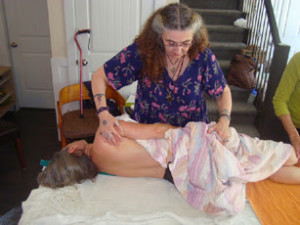
Pashta MaryMoon demonstrates how to roll a body so it can be washed and prepared for a home funeral
(Credit: plus.google.com)
A traditional funeral organized through a funeral home can cost upwards of $5,000 to $10,000 if you include a casket, chapel ceremony, the whole thing. The cost of a very basic home funeral is almost nothing, but you still need to take into account the disposition of remains, including whether a shroud, basic cardboard or wooden coffin is used, whether it’s from a large supplier or handmade by an artisan, etc. I know a family who recently released cocooned butterflies as ashes were spread – that’s several hundred dollars right there. It’s entirely up to the family, and there are lots of factors. But generally, a home funeral is much more economical. If you’re working with a Death Midwife, they will likely charge a fee. Personally, I charge $1,200 for a guaranteed minimum of 25 hours of service, which includes a funeral and/or memorial service and initial grief support. That’s on par with what you’re charged when you walk into a funeral home to make basic arrangements – without the embalming, visitation, funeral, coffin or anything. And you get about three hours of their time.
Even though using things you already have in the home is more cost effective, there’s also something very meaningful about using the same towel that you always used to dry off Mom after giving her a sponge bath. When you use that towel for the last time to clean her body, that can create a sense of closure that is very helpful in the grieving process. For primary caregivers – usually a member of the family – there is great benefit in participating in post-death care. That person has been orienting their life around caregiving for weeks, months, probably for years (because of medical technology, our dying is so prolonged these days). For however long they’ve been caregiving, even if they’re still working and have other responsibilities, they’ve built their lives around the needs of the dying person, even when residential care is involved. That only covers the basic physical aspect. The family caregiver is still making sure that their loved one’s needs are getting met – that they have appropriate clothing, enough toothpaste, that they’re going outside to enjoy the world and can still see through their glasses.
Caregivers never know when the last act of caring will happen, so when they participate in a home funeral, they are guaranteed one more opportunity to offer an act of love, care and respect after their loved one has stopped breathing. If a body goes to a funeral home, usually an hour after death, a caregiver’s sense of identity and self worth are suddenly gone, and they’re left with little opportunity to shift out of their role. Over the duration of a home funeral, there is the opportunity to do that. Yes, the Techni Ice still needs to be replaced, but that’s the only major need.
There is also the chance to realize that the person they loved is no longer in the body, so that by the end of the home funeral – if things are happening in a healthy way – they’ve emotionally disconnected from the body. When a body is taken away an hour after death, the body and the person who used to inhabit it are still associated with each other. These days, open casket funerals are becoming less and less common, so fewer and fewer people are having that chance to go through that healthy dissociation process, which is needed not just for caregivers, but for everyone who had a relationship with the deceased.
There’s also the matter of resentment and guilt in the family – particularly guilt around how caregiving often falls to a particular person. A home funeral gives other family members a chance to do some of the caregiving and organizing, which helps balance things out a bit.
Juniper: How do you see the role of the Death Midwife in facilitating community cohesion?
Pashta: Natural grieving goes through several stages and takes many forms. There are tears and sadness; anger at the situation, the dead person, and oneself (all the things you could have done but didn’t). But then there’s laughter, and the need to deal with mundane things, and nothing unfolds in a pre-determined order. But it goes like that, moving in and out of intense emotions. That’s healthy grieving. When you’re doing a home funeral, sometimes the tears just pour, but then someone might drop the toothbrush being used to clean their loved one’s teeth, and everyone will start laughing. Then someone will need to go get another towel because there aren’t enough, or put on a pot of tea because everyone has been washing the body, standing for a long time, and singing, and their voices are giving out, and they’re tired. There’s also the tasks of doing paperwork, feeding people, greeting visitors… there’s a rhythm that unfolds in those three to six days, going into and out of different kinds of emotion. It’s much healthier than just being in grief, or just in “crisis calm,” which is what most people default to after a death. This is a kind of numbness or shock, where tears spurt up once in a while, but mostly the emotions are cut off. This is a survival response that allows people to deal with practical things. But in a home funeral setting there are several people doing organizational tasks, and there’s time to feel, and people to witness and mirror those emotions.
In our culture, we are so isolated in grief. Most employers give a maximum of two weeks bereavement leave, and then it’s back to work like nothing’s changed. No one wants you to cry in front of them, and you might not want to cry in front of anyone else because they may still be grieving a loved one and you might trigger their tears – and we’re not supposed to make people cry. No one wants to talk about it or let it happen, so all that emotion gets held inside. That you’re grieving the loss of a relationship in isolation from your remaining relationships makes the wound even deeper. When you have that three to six days to cry, laugh, do mundane things, go out and play basketball then come back and cry some more, there’s a community of grief created where everyone has permission – to grieve, yes, but also to laugh, be angry, be relieved. That’s a big one in our culture. You’re not allowed to say, “My mom finally died and I’m so relieved!” And we are not allowed to say to people who have been caregiving for a long time, “I’m so glad that your mom died – that she’s released, and you’re released.” Yet, that’s a reality.
It didn’t used to be the case that people had a prolonged dying over several years, but now it’s common and we need to give each other permission to acknowledge that. The foundation of this permission is built during a home funeral, but it extends beyond that. People feel like they’re able to call each other up and be received when they’re having a hard day and grief is really present for them. There is none of that common fear that when someone goes into grief, they may stay there forever, get highly depressed and commit suicide. Because they’ve already experienced and witnessed in each other that cycle of emotions, they know that they will be able to carry on with the rest of their lives after a moment of catharsis, so it’s okay to let it happen. This also makes it a lot easier to plan things like what you’re going to do with your loved one’s ashes. There are so many boxes of ashes sitting in the back of closets because the family won’t get together to talk about it out of fear that they’ll prolong the grieving process. The one-year anniversary of a death can be even more emotional than the initial loss, so when permission to grieve is already established, it can make that experience more meaningful and helpful for everyone.
Keep an eye out for part three of this three-part interview next week.

 Why is Death Midwifery Important? An Interview with Pashta MaryMoon, Part Two
Why is Death Midwifery Important? An Interview with Pashta MaryMoon, Part Two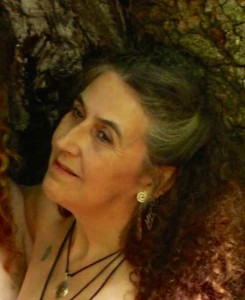
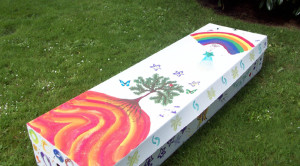
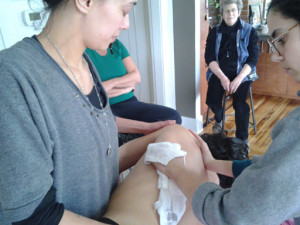



 Funeral Home Owner Chris Johnson Spending Halloween in Jail
Funeral Home Owner Chris Johnson Spending Halloween in Jail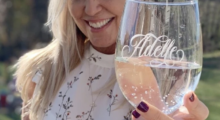
 Our Monthly Tip: Toast a Loved One with a Personalized Glass
Our Monthly Tip: Toast a Loved One with a Personalized Glass
 My Cousin’s Death Taught Me the Meaning of Life
My Cousin’s Death Taught Me the Meaning of Life














